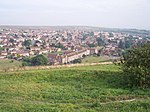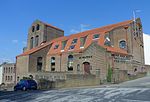Whitehawk Hill transmitting station

The Whitehawk Hill transmitting station (also known as the Whitehawk transmitting station) is a broadcasting and telecommunications facility located at Whitehawk, an eastern suburb of Brighton in the English city of Brighton and Hove. It is the city's main transmission facility for television and radio signals. It broadcasts digital television, FM and DAB radio to the coastal city of Brighton and Hove and to surrounding areas along the Sussex coast. It stopped broadcasting analogue television when the digital switchover occurred locally in March 2012. Services broadcast include BBC One (South East), BBC Two, ITV (Meridian), Channel 4, BBC national radio stations, BBC Sussex and Heart Sussex.
Excerpt from the Wikipedia article Whitehawk Hill transmitting station (License: CC BY-SA 3.0, Authors, Images).Whitehawk Hill transmitting station
Warren Road, Brighton Whitehawk
Geographical coordinates (GPS) Address Nearby Places Show on map
Geographical coordinates (GPS)
| Latitude | Longitude |
|---|---|
| N 50.83 ° | E -0.11 ° |
Address
Whitehawk Hill Local Nature Reserve
Warren Road
BN2 3EA Brighton, Whitehawk
England, United Kingdom
Open on Google Maps










